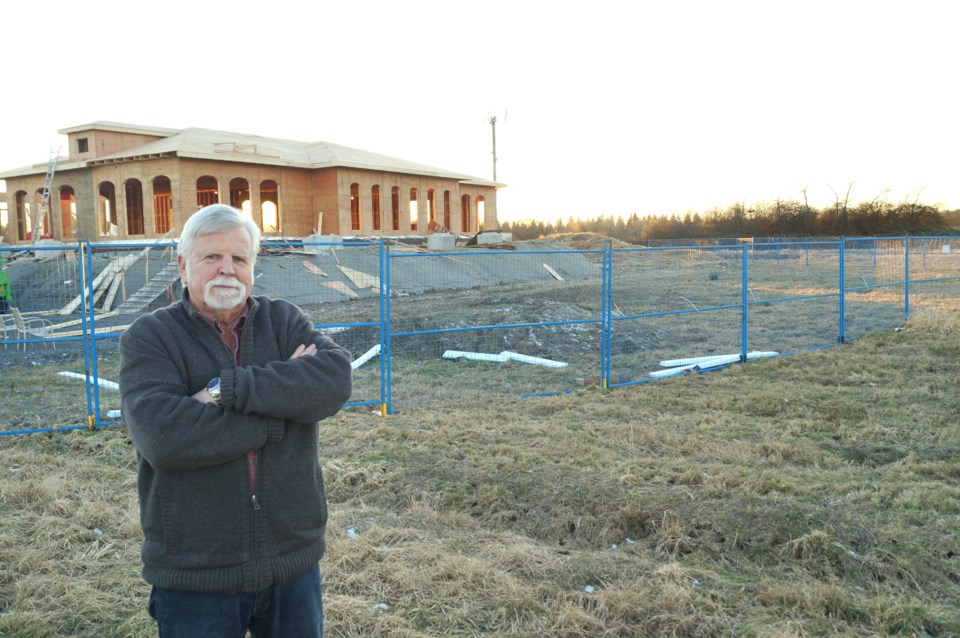Seven of nine city councillors have directed staff to begin consulting the public, including local farmers, this March with respect to limiting house sizes on protected agricultural land.
But Coun. Carol Day wanted to turf the proposed consultation process and immediately draft a bylaw to limit house sizes on the Agricultural Land Reserve (ALR) to 7,500-square-feet. While Day’s choice departed from her usual calls to broaden and expand public consultation, it fell in line with many of her votes that either reject or slow down the pace of development in the city.
Day and Coun. Harold Steves — who also voted against consultation — argued an immediate bylaw, however temporary, would have curbed a potential rush for building permits.
“I don’t think we need an extensive public consultation process. I think we know what we’re going to hear,” said Day.
But, the matter is more “complex,” noted Coun. Linda McPhail, at city hall Monday night.
Indeed, cultural factors were at play, as councillors were privy to a number of Southeast Asian land owners who claimed large homes are necessary for extended families that are needed to farm their east Richmond land, which is some of the best in Canada for vegetable production.
At issue is the proliferation of large homes, some reaching over 20,000-square-feet in size.
Farmer Gary Brar told council an 11,000-square-foot house is acceptable for an extended family.
“We like to live under the same roof,” said Brar.
“If you look at our culture . . . our first guru was a farmer himself,” added Brar.
Meanwhile, Caucasian speakers mostly spoke to the need to expedite the process.
ALR land owner John Baines questioned if the extended families simply “want to live luxuriously.”
Coun. Alexa Loo countered: “I don’t know how many people would consider living with their mother-in-law luxury living.”
Loo said Southeast Asian culture must be respected and farmers should come up with solutions during the consultation process.
Baines said farmers’ interests are increasingly coming into conflict with one another: whereas while they want to farm, they are also faced with multi-million dollar offers for their property.
“Do people take the money and run or continue to try to farm?” asked Baines.
Gurdial Badh, a realtor and farmer of a 20-acre plot of blueberries in Richmond, said people in west Richmond “aren’t wearing farmers’ boots like I do.”
Steves argued that if extended families are an issue, they can be dealt with on a case-by-case basis. Mayor Malcolm Brodie said that may prove difficult to track, as an extended family could apply to build a large home but then sell it later.
Land owner and farmer Ron Hung said the city should look to Surrey for regulation guidelines. Notably, Surrey only limits what is called a “home plate,” or an area whereby a house, secondary house, accessory buildings, landscaped features and farm roads can be built.
In Surrey, 20,000-square-foot homes are possible, and reportedly becoming a common site.
All Richmond councillors appeared to confirm such homes are a problem.
“There’s little doubt things need to be tightened up,” said Coun. Ken Johnston.
But how big is too big is what the consultation process will determine.
Meanwhile, Coun. Bill McNulty blamed the provincial government for ALR home size proliferation in Richmond. He said the Ministry of Agriculture should have enforced its own guidelines as law. However, municipalities do have the authority to enact their own bylaws, as Port Coquitlam and Delta have done.
Ministry guidelines state an ALR house should be no bigger than 5,382-square-feet. Steves was the only councillor to openly suggest the city, at a minimum, should adopt the guidelines as law. Day said her proposal was a “compromise,” which roughly doubles what the Corporation of Delta allows.
One issue that requires addressing, said Steves, is houses on small ALR lots (530 properties have a width of 33-metres or less). As it stands, much of the land can be developed. Steves suggested protecting two-thirds of such lots.
The lots, Steves noted, were created for war veterans after each world war, and are unique to Richmond. Now, Steves added, they are being sold for millions of dollars as real estate agents market them here and abroad.
Brodie said the fact a new 15 per cent foreign buyers’ tax on residential property wasn’t applied to farmland has had “a magnetic effect on speculators.”
Such buyers take advantage of what Metro Vancouver has called favourable tax breaks for farm-class properties.



